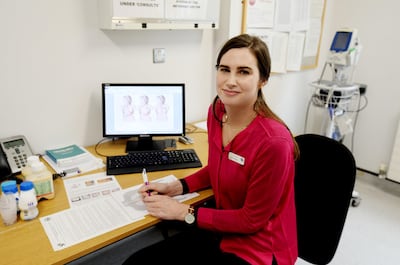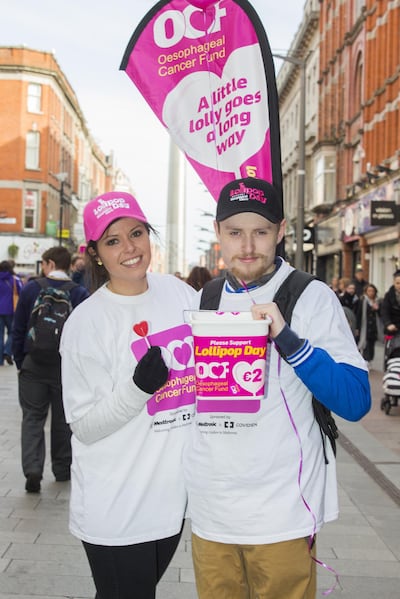Brona Wright goes to the gym, runs mini-marathons and enjoys a "really full life" after developing oesophageal cancer nearly 12 years ago at the age of 44. But the way she eats has had to change for ever.
No more sitting down to three big meals a day. Instead she has to “graze” and, through trial and error, she has learnt the type of foods that are best to avoid, or at least minimise.
When a malignant tumour was found at the base of her oesophagus, she had to have the whole food tube – leading from the mouth to the stomach – removed. During this complex surgery, known as an oesophagectomy, the stomach is pulled up into the chest and part of the lining used to create a replacement food tube.
After this major operation, it was like learning to eat all over again, she says, progressing from liquids and purees to mashes and then more normal foodstuffs.
Therefore dietitians, as well as surgeons, have a vital role to play in survivors’ recovery from this type of cancer. Staving off rapid weight loss and ensuring the body is as well nourished as possible is crucial – both before and after treatment.
The earlier we see these patients in their "cancer journey" the better because they are at a high risk of malnutrition and weight loss, says Cathy White, a senior dietitian at Beaumont Hospital in Dublin. About 80 per cent have lost weight before their diagnosis of this type of cancer, for which there is a high mortality rate, mainly because it is has often spread before it is detected.

Difficulty in swallowing is the most common reason those affected seek medical help but other symptoms include frequent and persistent hiccups; acid indigestion, heartburn and reflux; constant belching, burping and coughing. In only about 45 per cent of cases will the cancer be confined to the oesophagus when diagnosed and treated with “curative intent”. The treatment could involve surgery, or surgery preceded by combination chemotherapy alone or combined with radiation therapy, or, occasionally, radical radiation therapy in combination with chemotherapy and no surgery.
Even a 10 per cent weight loss before treatment can influence post-op recovery, infection rate and complications, says White. So that is why dietitians try to get in ahead of that, meeting patients at the time of diagnosis, to make a full nutrition assessment to ensure they are going into their surgery “replete rather than deplete”.
In some cases, “that surgery will even be delayed until their nutritional status has improved”, she says. Depending on the severity of the symptoms, this may have to be done with the use of a feeding tube, by-passing the affected area.
Cancer patients are generally very motivated to help themselves but also vulnerable. They may be susceptible to fad diets promoted by self-appointed food “experts” rather than trained dietitians. Invariably, says White, such diets “are restriction-based and are not going to help them” – or may, indeed, have adverse effects.
Just before surgery, White will sit down with the patient and family to talk about some of what to expect afterwards. Understandably, there tends to be a huge focus on the upcoming operation, but she also tries to prepare them for the recovery period and how challenging that can be
“In hospital, they are only off food for five or seven days, if everything goes to plan, and then we start introducing a diet again. But because everything has been replumbed and rewired in there, we can’t just jump back into eating normally.”
A feeding tube is placed into the small intestine during surgery, "so we can feed from 8am in the morning after their surgery", says Michelle Fanning, a clinical specialist dietitian at St James's Hospital in Dublin, which is the national centre for oesophageal cancer and treats about 70 cases a year. It may take between four and eight days for the surgical "join" of the new food pipe to heal and seal. Only after a "moving X-ray" has shown there is no leak, can liquid and "sloppy" food by mouth be gradually reintroduced. It's then the real challenge of living with a reconfigured digestive system begins. When you think of the stomach being stretched up to the neck, it's easy to understand how its capacity will be reduced, as will its efficiency in pulverising food before it passes into the small intestine.
Only very small portions are possible at first, so supplementary nutrition through the tube is essential for some time. Before patients are discharged, typically around a fortnight after the operation, a dietitian will teach them to use tube-feeding overnight at home.
“We send them home and then see them maybe two weeks later in outpatients – but would usually have telephone contact with them before that,” says White. They can expect to use the tube for about a month, getting about one-third of their nutrition needs through it and the other two-thirds through food.
The dietary strategies that White and Fanning give their patients are the front-line defence against various problems that are likely arise over the coming weeks, months and even years. “It is through these dietary strategies that we try to achieve an adequate nutrient intake, minimise gastrointestinal symptoms after eating and enhance absorption of nutrients,” says Fanning.
It is difficult to maintain your weight after the operation – it is even more difficult to regain weight lost
At the outset, these strategies are key in determining how quickly they recover from the surgery. “If they are not meeting their nutritional needs, they are going to get weaker; they are not going to be able to do their exercise, their muscle function isn’t going to come back, their strength isn’t going to come back. It is difficult to maintain your weight after the operation – it is even more difficult to regain weight lost. We don’t want to let anything slide,” says White.
One problematic change is loss of appetite because the surgery affects the nerves and hormones involved in digestion. Patients need to learn to “eat by the clock” because the signals that would usually be sent to your brain to tell you that you are hungry, or full, won’t be working as well.
It would be easy to go most of the day without eating anything unless you make a conscious effort, says White. But “if you haven’t eaten five or six times during the day, you can’t catch up in the evening because the body won’t tolerate a big meal”.
The ongoing difficulties can include nausea, vomiting, reflux, diarrhoea and “dumping” syndrome – when food flows too quickly into the small intestine, which then pulls in water through the bowel wall in an effort to cope with the onslaught and that in turn affects blood pressure or causes urgent diarrhoea.
Which patient will have which symptoms and how severe they may be is very difficult to predict, says Fanning, sitting in a consulting room of the multi-disciplinary, oesophagean/gastric cancer out-patient clinic at St James’s. Earlier, she saw four patients who had all had an oesophagectomy about six weeks previously.
There’s “always a mixed picture” at that stage, she says. “Each person is different and also the way the gut adopts and the way the symptoms manifest does vary.”
At this check-up she is not only reviewing what they are eating but also linking it to symptoms being experienced. “For a patient who may have many different symptoms, you are de-tangling that for them.”
Of the four, three were doing really well – and she was able to reassure them of that. They had either managed to maintain their weight or their weight change had been small or acceptable.
“With such major surgery to the digestive gut, we expect weight loss. The overnight feed has mitigated some of it.” However, two-thirds of patients will have lost 10 per cent of their body weight by six months.
“For somebody who used to diet a lot, I found trying to put on weight much, much harder than trying to lose it,” says Wright. She just didn’t want to eat for many months after surgery.

“My fear about eating was that I would be ill afterwards. I carried what used to be my mother’s Christmas pudding bowl around in my bag all the time.”
She gradually improved with the help of doctors and dietitians but every bit of food she could manage had to count.
“I had to have nourishment and nutrition and all the food groups,” she points out. “The first couple of years were very, very tough for me.”
For at least a year, she was very iffy about food. She counts herself lucky that she didn’t have children she had to prepare food for and that her husband cooked in the evening. What’s more her mother, who lived close to her home in Cabinteely, Co Dublin, used to cook dainty, appetising-looking meals to encourage her to eat.
Now she is happy to say “I can eat virtually anything but I know my limits in terms of what I can and can’t eat”. She finds anything very sweet or greasy hard to take. If she goes too long without eating, she can feel “clamping” in her stomach.
Wright needs to be “pushing something into the system” every couple of hours, between small meals. “Nothing puts me off more than the sight of a lot of food on a plate.”
However, eating out is no longer the ordeal it once was. She either orders two starters or skips the starter and has a main course but would never have a dessert.
“I have learned to slow down when I’m eating – it has taught me to use my teeth more.”
Wright considers herself lucky that it was caught in time – having a history of heartburn, she had gone to the doctor when she had blood in her stools and spells of feeling light-headed; a bleeding ulcer was suspected. It was on further investigation that the cancer was discovered. She was told that she was a very untypical patient, in that oesophageal cancer usually occurred in older men who had been hard drinkers and smokers – “I did neither of those and I was only 44”.

Early detection is key, stresses Wright, who would urge anybody experiencing one or more of the symptoms (see panel) to go to the doctor. The day before we talk, she was bag-packing in Cornelscourt in aid of the Oesophageal Cancer Fund, and recalls that a number of people said to her that they had lost very good friends to the disease. In one case, it was as quickly as seven weeks after diagnosis because the cancer was so far advanced.
Latest available figures from the National Cancer Registry of Ireland record 396 new cases in 2014 (compared with 2,928 cases of breast cancer) but the five-year survival rate given is just 20 per cent, whereas for breast cancer it's 86 per cent. Incidence is rising here and globally, which is linked to increased numbers of people who are overweight or obese; long-term acid reflux is more common in people who are overweight.
It is only through awareness-raising and funding of research that the mortality rate will improve. And the Oesophageal Cancer Fund (OCF) does both of these through its annual Lollipop Day, which in fact runs over two days, on February 23rd and 24th this year.
The inspiration for this venture was Lucilla Hyland, who was diagnosed with oesophageal cancer back in March 2001, just after her 41st birthday. She kept saying to a group of old schoolfriends from Holy Child, Killiney, in Co Dublin, "why doesn't anybody know about this cancer?".
To give Lucilla, an event manager, a focal point during her treatment, they agreed to help organise a fund-raising ball, explains one of those friends, Noelle Ryan, who is chairwoman of the OCF.
“Her consultant had said she will have her surgery in June; organise it for the end of September/beginning of October and she will be well enough to be there – if not dancing on the tables. So that is exactly what we did but, sadly, she died in August. So, it was a very emotional night but we raised far more money than we dreamt we could; then the onus was on us to decide what to do with this money.”

The consultant suggested they use it for awareness-raising campaigns, as had been done for other forms of cancer, and so the OCF was born. It started the annual Lollipop Day appeal the following year.
The proceeds have gone towards initiatives such as the setting up of a National Barrett’s Registry. This is important because about 10 per cent of people with gastro-oesophageal reflux disease, or GORD, develop Barrett’s Oesophagus, which in turn increases the risk of cancer, so needs monitoring.
It is also funding pioneering work at the Cork Cancer Research Centre where Dr Declan Soden has developed "tumour electro shock" treatment for cancers. Phase one of international trials using this technology in the oesophagus via an endoscope has just been completed.
Lollipop Day is on February 23rd and 24th. For more information, see lollipopday.ie.
OESOPHAGEAL CANCER BY NUMBERS
- 400 new cases diagnosed in Ireland every year
- 3 times more men than women affected
- 45 per cent of cases treated with "curative intent"
- 20 per cent survival rate (at five years), for all stages at diagnosis
- 600 per cent increase in oesophageal cancer worldwide over the past 30 years
EARLY WARNING SYMPTOMS
- Frequent and persistent hiccups
- Acid indigestion, heartburn, reflux
- Difficulty when swallowing food
- Constant belching, burping, coughing
- Weight loss
LIFESTYLE FACTORS LINKED TO INCREASED RISK
- Being overweight or obese
- Smoking
- Consumption of alcohol
- Very hot drinks – when combined with the above two factors
- Eating processed meat
- Diet lacking in vegetables and fruit
Read: We chatted alien movies, then he showed how he'd cut me open









